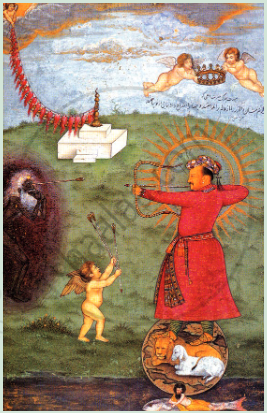Advertisements
Advertisements
प्रश्न
Write a Short Essay (About 250-300 Words) on the Following:-
Identify the elements that went into the making of the Mughal ideal of kingship.
उत्तर
(i) According to Akbar's court poet, Abu’l Fazl Mughal kingship as the highest station in the hierarchy of objects receiving light emanating from God (farr-i- izadi). According to this idea, there was a Hierarchy in which the Divine Light was transmitted to the king (Mughal Emperor) who then became the source of spiritual guidance for his subjects.
(ii) Mughal chronicles present the empire as comprising many different ethnic and religious communities – Hindus, Jainas, Zoroastrians, and Muslims. As the source of all peace and stability, the emperor stood above all religious and ethnic groups, mediated among them, and ensured that justice and peace prevailed.
(iii) Abu’l Fazl describes the ideal of sulh-i kul (absolute peace) as the cornerstone of enlightened rule. In sulh-i kul all religions and schools of thought had freedom of expression but on condition that they did not undermine the authority of the state or fight among themselves The ideal of sulh-i kul was implemented through state policies – the nobility under the Mughals was a composite one comprising Iranis, Taranis, Afghans, Rajputs, Qeccanis – all of whom were given positions and awards purely on the basis of their service and loyalty to the king.
(iv) Akbar abolished the tax on pilgrimage in 1563 and jizya in 1564 as the two were based on religious discrimination. Instructions were sent to officers of the empire to follow the concept of sulh-i kul
(v) All Mughal emperors gave grants to support the buildings and maintenance of places of worship. However, it was during the reign of Aurangzeb, the jizya was re¬imposed on non-Muslim subjects.
(vi) Abu’l Fazl defined sovereignty as a social contract. According to him, the emperor protects the four essences of subjects, namely, life (Jan), property (mal), honor (narnus) and faith (din), and in return demands obedience and a share of resources from the people. Only sovereigns were thought to be able to honour the contract with power and Divine guidance.
APPEARS IN
संबंधित प्रश्न
What is the meaning of sulh-i-kul?
Study this Mughal painting entitled 'Jahangir Shooting the Figure of Poverty' carefully and answer the following question by choosing the correct option:

The artist has enveloped the target in a dark cloud to suggest: ______
Study this Mughal painting entitled 'Jahangir Shooting the Figure of Poverty' carefully and answer the following question by choosing the correct option:

The animals are seen in the painting underneath the feet of the emperor stand for: ______
Study this Mughal painting entitled 'Jahangir Shooting the Figure of Poverty' carefully and answer the following question by choosing the correct option:

The chain descending from heaven is a symbol of: ______
Study this Mughal painting entitled 'Jahangir Shooting the Figure of Poverty' carefully and answer the following question by choosing the correct option:

The ‘halo’ shown around the face of Jehangir indicates: ______
Read the source given below and answer the questions that follow.
The flight of the written word
In Abu’l Fazl’s words:
The written word may embody the wisdom of bygone ages and may become a means to intellectual progress. The spoken word goes to the heart of those who are present to hear it. The written word gives wisdom to those who are near and far. If it was not for the written word, the spoken word would soon die, and no keepsake would be left us from those who are passed away. Superficial observers see in the letter a dark figure, but the deep sighted see in it a lamp of wisdom (chirag-i shinasai ). The written word looks black, notwithstanding the thousand rays within it, or it is a light with a mole on it that wards off the evil eye. A letter (khat) is the portrait of wisdom; a rough sketch from the realm of ideas; a dark light ushering in day; a black cloud pregnant with knowledge; speaking though dumb; stationary yet travelling; stretched on the sheet, and yet soaring upwards.
- Why were words considered as the lamp of wisdom?
- How has Abul Fazal related words with knowledge?
- How did Abul Fazal refer to the difference between a ‘common viewer's observation’ and the ‘observation of a learned person?
In which year Akbar abolished the tax on Pilgrimage?
During the reign of which of the following rulers was Jizya reimposed on non-Muslim subjects?
